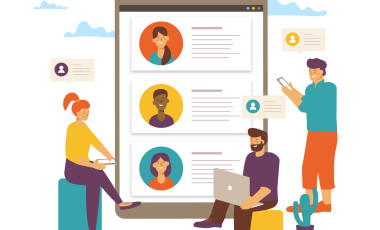Strategies To Boost Customer Satisfaction In Small Businesses
Customer satisfaction is one of the critical factors that can make or break small businesses. Every small business that aims to succeed should employ effective ways to boost customer satisfaction.
Businesses can use different strategies that can place them ahead of the pack. These strategies range from utilizing customer survey data to boosting employee satisfaction. This article will discuss all of these strategies in great detail.
What Is Customer Satisfaction?
Customer satisfaction refers to how well a service provider can meet the needs of his customers. It can be viewed as a scale that weighs how happy consumers are with their services. Companies that prioritize customer satisfaction generate 5.7 times more revenue than companies that neglect customer satisfaction.
96% of customers are more likely to be loyal to a brand that prioritizes customer satisfaction.
Traditional methods of getting feedback from customers have their shortcomings. Instead of just working with small sample lengths, businesses can get feedback from customer interactions by creating an omnichannel feedback platform. For this, CX platforms come in handy.
Why Boost Customer Satisfaction?
Customers are an essential part of any business. They hold the key to success. Higher customer satisfaction means more customer loyalty and retention.
Customer satisfaction can also help measure the likelihood of customers becoming long-term buyers. It can also act as a litmus test that alerts businesses if there is a risk of losing customers. Collecting customer satisfaction data will help companies improve areas that are lacking and pinpoint areas that are doing exceptionally well. IBM was ranked number one when it comes to customer satisfaction.
Strategies To Boost Customer Satisfaction
If a small business has to be a raging success, it must employ strategies to boost customer satisfaction. Customer satisfaction breeds customer loyalty, which translates to more revenue and better reviews.
Let's look at a few invaluable strategies in detail.
Provide Customers With Multichannel Support
In today's business world, customers have their pick of communication channels. Businesses should provide a seamless experience by taking the omnichannel approach. Connecting with customers on their preferred channels reduces the chances of frustration.
Omnichannel customers spend about 50 to 300% more than single-channel shoppers.
The omnichannel approach makes it possible for customers to transition smoothly from one platform to the other. This approach also removes the need for consumers to repeat the same request when they switch to a different platform, which can be pretty inconvenient. Any small business should aim to make a customer's life easier to boost reputation and retain customers.
Focus On Employee Satisfaction
Happy employees translate to satisfied customers. If your employees are comfortable in the work environment, they perform better and provide better customer service.
A one-star boost in employee satisfaction translates to a 3.2 point boost in customer satisfaction.
Your employees are your most direct connection to your customers, so keeping them happy and making a good impression is vital.
Make it a priority to celebrate hard work and introduce employee recognition programs. These programs can range from an employee of the year awards, vouchers, and more. You can also create a platform where employees can air different concerns. Each concern should be given consideration.
Employee health should also be a priority. Make it a point to provide employees with everything to make their jobs run more efficiently. It can include upgrading facilities, simple housekeeping, and taking care of the environment.
Utilize Your Customer Survey Data
Customer survey data reflects the experiences customers have while using your product. Businesses can get real-time feedback from consumers and analyze customer interactions to see areas that need improvement. Analyzing customer satisfaction survey data will make it possible to work using more than just trends or instinct.
Different types of surveys have different goals. Some surveys can measure how familiar customers are with particular products. Other types of surveys measure how happy customers are with different products.
CxP or a Customer Experience Platform - Collection of tools that allows companies to monitor and manage their interactions with the customers
Surveys also make it possible for businesses to personalize their customer experiences and ensure satisfaction at an individual level. An excellent example of this is how Facebook receives real-time feedback from customers and uses that for personalizing the customer experience.
Keep Abreast With Customer Reviews
Social media makes it possible for customers to go on any chosen platform and share how they feel about different products. Small businesses should have a system where they observe social media trends.
Social media can also be used to respond to queries from customers. Logging into a social media platform and observing what people say about the business and its products can come in handy. In 2020 alone, over 3.6 billion people worldwide had been active on social media.
By 2025, 4.41 billion people will be active on social media.
Social media makes potential buyers aware of a company's products. Responding promptly to queries also helps businesses engage with customers on their platform of choice and increase customer satisfaction.
The information extracted from observing social media interactions will highlight areas that need improvement. It will also isolate the most popular products and services.
Most potential customers go through the reviews before they make a purchase online. Businesses can use those reviews as a marketing tool. A page for testimonials can influence an individual's purchasing choices. The best reviews should also be highlighted on the business website pages.
Personalize And Offer Proactive Customer Service
Anticipate what customers need and get in contact with them before they contact you. Communication should be personalized to make the customer feel comfortable and valued. A good example is how Starbucks made its app intuitive and capable of anticipating a customer's needs. Starbucks uses an AI algorithm to send personalized messages and unique offers to each customer.
Contact customers to remind them to make a payment or alert them if there's a new product they might be interested in. Use the customer's name if possible. If it is face-to-face interaction, make it a point to be warm and welcoming.
Create and implement customer loyalty programs. Businesses can offer vouchers as prizes or offer a discount for regular customers. Make use of digital loyalty programs. Digital loyalty programs are a more modernized approach to making customers feel valued and rewarding them for their loyalty and consistency.
Loyalty programs encourage repeat buying and also boost customer satisfaction. The more a customer spends, the more rewards they are likely to receive.
Final Word
Building and maintaining a loyal customer base is one of the biggest challenges in small businesses. CxP's can help deliver optimum digital experience to make this a reality. Ensuring that customers are happy with the services and products being offered is the most efficient way to boost customer satisfaction.
Make customers a priority. Making them feel valued will give them a sense of belonging and ensure that they return.
Create a seamless experience and ensure that customers are met with warmth and smiles from employees. It will make all the difference.
Happy customers market products and refer more buyers. Small businesses should utilize social media and survey data to ensure that customers are satisfied and are getting value for their money. Each strategy of boosting customer service brings rewards. Businesses should focus more on interaction and satisfaction than making quick profits, and they will thrive.



